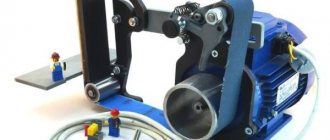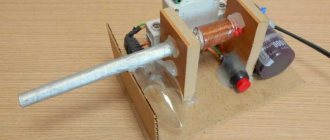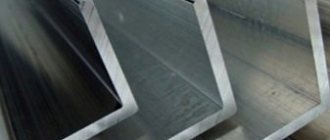Grinder is a belt grinding machine used for dry grinding of products made of metal, various alloys, wood, artificial stone, plastic and other materials.
Homemade grinder assembly
The question of how to make a belt grinder with your own hands is asked by many home craftsmen, because with the help of such equipment you can perform various technological operations with products made from various materials. Using a belt grinder, you can remove burrs, eliminate surface defects, remove rust, remove flash, eliminate the effects of plasma and laser cutting, and clean welds.
Types of grinding machines
When working closely with wooden parts and objects, the craftsman needs to know what types of wood sanding machines there are in order to select the most optimal device for himself.
Based on the design principle, types of wood sanding machines are divided into 3 types: belt (grinder), disk, drum.
- The band press is considered the most common. The abrasive coated belt is mounted on two shafts, which are driven by an asynchronous motor. In this case, the grinding element can be located in a horizontal or vertical position. During operation, the tape does not sag, but processes the wood without generating a large friction force. This design can be used when processing long parts.
- The disk unit, or as it is also called a disc grinding machine, is equipped with an axis to which an abrasive wheel is attached. During operation, the disk begins to rotate around its axis. During operation, you can adjust the speed of the wheel with an abrasive coating without reducing the speed of the axis itself.
- The disk unit, or as it is also called a disc grinding machine, is equipped with an axis to which an abrasive wheel is attached. During operation, the disk begins to rotate around its axis. During operation, you can adjust the speed of the wheel with an abrasive coating without reducing the speed of the axis itself.
- The drum machine is designed in such a way that abrasive belts in the form of a spiral are wound onto adjacent rollers. In turn, these elements are spaced a certain distance from a flat surface (table top). By adjusting this distance, you can calibrate the wooden parts.
There are other types of portable sanders. Drills and screwdrivers are often equipped with special attachments with abrasive coating.
The device and principle of operation in each version is different from each other. At the same time, the wood will be processed differently.
The easiest way to create a disc sander. But a homemade sharpening and grinding machine, based on a belt design, will be much more functional and in demand in the home workshop than any other.
Grinder and sharpener: a brief comparison
A belt grinder and a sharpener are analog devices, as they perform almost the same functions. But there are also differences in the quality of processing and design. The grinder has several advantages that a regular sharpening machine cannot boast of. This:
- precise processing geometry;
- simple replacement of abrasive tape;
- versatility of use.
Please note that due to the presence of a shaft and rollers, the tape becomes perfectly level. This makes it possible to more accurately position the workpiece for processing. As a result of cleaning parts, defects, nicks and burrs do not appear (this often happens when processing metal parts with a grinding wheel).
The grinder belt is made from strong sandpaper. For belt grinders, many belt options are sold with different abrasiveness. Having a whole set of them on the farm, you can perform work of varying complexity.
Schematic diagram of the grinder design and the principle of its operation
In order to correctly understand the structure and operating principle of the grinder, let us turn to its structure. The main task is to find a powerful motor that will need to be equipped with a drive.
Important! The torque is transmitted to the rollers, which drive the abrasive belt.
Appearance of the grinder
So, the main elements of the grinder, in addition to the engine, are:
- Straight roller with pulley.
- Tension rollers.
- Abrasive tape.
- Base.
- A device that fixes the tension of the belt and rollers.
- Table for fixing the part (in some models it can be rotary).
After connecting the device to the network, the rollers set the abrasive belt in motion. Moreover, the position of the rollers can be shifted to control the tension of the abrasive belt.
In some cases the table can be rotated 180°
When assembling the grinder yourself, it is important to position the rollers strictly perpendicular to each other to avoid distortions of the belt, which can lead to its breaks.
Advice! Before deciding on the size of the belt and the width of the rollers, figure out what surfaces you plan to process, their dimensions and volume of work.
Advantages and disadvantages
The advantages of grinding machines include:
- Quality and speed of processing.
- High performance.
- The ability to obtain the surface of the desired roughness.
- The ability to process not only the wood itself, but also pre-grind the finishing layer.
The disadvantages are:
- Release of a large amount of dust, requiring the organization of a dust removal system.
- Large quantities of consumables (abrasive) of several sizes.
- Difficult to manufacture and maintain (this especially applies to belt installations).
Considering the existing shortcomings, before starting assembly, you need to decide how necessary the machine is. If it will be used only occasionally, it is not practical to spend time on manufacturing - you can get by with hand tools.
Advantages of a homemade machine
A belt grinder can be purchased at any hardware store, but a hand-assembled machine has many advantages for the owner:
- Minimum costs for labor and materials.
- The ability to independently prepare a drawing (or use a ready-made project) with the proper dimensions, type of design and principle of operation.
- Most consumables are available in every craftsman's household; you just have to search in your own barn, pantry, or garage.
- The missing elements and accessories can be purchased at a construction supply store (fastening clips, guide and drive rollers, sanding belt). You can also make rollers for the grinder yourself.
- A large collection of videos on assembling a grinder with your own hands from scrap materials.
Masters are always presented with web portals with a large number of step-by-step instructions on how to make a grinder with your own hands, diagrams and ready-made drawings, and practical advice.
Drawing of a belt grinder tensioner for DIY assembly
Drawing of a belt grinder tensioner mechanism for DIY assembly
The support table and thrust platform of the Host belt grinder are made of 6 mm thick steel using welding and subsequent grinding of the seams. You will also need an M8x1.2 tap; the holes for this thread are marked with a diameter of 6.8 mm. As a thrust element of the grinder, we recommend using porcelain tiles; they have proven themselves better than high-alloy steel or cast iron, because... its density and durability are higher.
Possible uses of the grinder
An installation of this type, industrial or homemade, has several main areas of practical use. A well-assembled structure can be used in the following cases:
Processing of metal sheets after cutting (for example, additional processing of sheet iron before assembling a certain structure). Using a grinder belt allows you to get rid of sharp nicks, scale, and irregularities.
Sanding wooden surfaces in the manufacture of furniture (or its restoration), picture and mirror frames. All wood parts can be processed with a plane, but the quality of sanding in this case depends entirely on the skills and practical skills of the craftsman.
When using a grinding machine, a belt moving evenly along the axis produces high-quality processing, removing all roughness, nicks, and sharp knots.
Sharpening knives and scissors. Very often you have to deal with the problem of a dull kitchen knife or textile scissors. This issue is especially relevant for seamstresses who operate from home. In such cases, having a sanding machine on hand will be an obvious advantage.
Today there is a wide variety of professions and hobbies. Most of them require specialized tools, including a grinder.
You can assemble a machine of this type with your own hands, using step-by-step instructions and a series of video tutorials. Drawings with dimensions and videos on assembling a grinder with your own hands can be found on practical construction web portals.
What is a grinder
A homemade grinder, assembled with your own hands, is a stationary machine that has a main belt for grinding parts. With the help of two rollers (drive and guide), the tape rotates around a certain axis.
The number of revolutions depends on the power of the design, the motor (drive) used and the quality of self-assembly. On the lower contour, such accessories have several clamps, with the help of which the machine is secured to a workbench or other working surface.
Often, clamps for fastening are additionally mounted on the side contour (reliable fastening allows for optimal processing, without gross defects).
Drawings with the dimensions of a simple grinder for do-it-yourself work will allow you to optimally observe the basic principles of the design, ensuring the further operation of the machine.
Grinder “from Chapai” - a brief overview
Grinders from Andrey Chapai have already become a household name. Hundreds and thousands of samples of grinding machines “from Chapay” have settled in the workshops of craftsmen in Russia and neighboring countries. The peculiarity of GCs (grinders from Chapai) is that they are universal and are created based on the needs of the customer: for sharpening knives or processing wood, with or without a certain type of engine. There are both mobile versions for home processing of products, and professional models.
Grinder “from Chapaya” is a universal machine for processing complex-shaped products made of metal, plastic and wood
You can buy a product, as they say, “turnkey”, or you can choose a modest set of tools and equipment.
At the moment, the most popular models of MGs are: GC-10, GC-12, GC-16 (professional series), as well as new mobile versions of the grinder 610 series GC610-63 and GC610 -71" - manufactured with zinc coating
General points characteristic of all machines:
- All mating surfaces of the grinder are polished. This helps to eliminate distortions during the running of the belt.
- Grinders come without painting or coating. The surfaces of the MS (short for grinder from Chapai) work for sliding. To prevent corrosion of the product, it is enough to periodically wipe it with a special oil or silicone spray.
- Unique pressure pad design.
I would like to dwell on the last point in more detail. The master came up with a unique design for this platform with the same size of 165x50 mm, there are 2 rotation positions for the base and two stop positions for the frame.
Options for rotating the pressure table and attaching it to the stop
Additionally, the set of tools and equipment includes a wheel for installation instead of the drive roller. It is recommended to be used when working on metal, when large amounts of paint or rust have to be removed.
Turning wheel with polyurethane coating, it is very convenient when adjusting and grinding concave slopes of products
Let's take a closer look at one of the professional models. The GC-16 is made on a reinforced rotary frame with 2 racks made of 12 mm thick sheet, which provides the necessary rigidity and allows you to quickly move the grinder to a vertical or horizontal position.
Grinder “from Chapai” – GCH -16. Appearance:
The design uses an enlarged sanding belt - 1600−1800×50 mm. And a fairly powerful engine - 2.2 kW. The machine has higher productivity and is ideal for continuous work in large industrial production. The price of such a product currently varies from 55,000 to 60,000 rubles.
Necessity at work and at home
Today, grinding machines are used constantly in production shops. Depending on the scale of production, either one machine or all its varieties in complexity and size can be installed.
However, there is always a use for this equipment in everyday life. Some people have a bench sanding machine for metal processing in their garage. Others have several wood grinding machines of different designs installed in their workshop. Still others own a universal, combined machine. There are power tools for manual grinding: drum type, belt grinder, band saw, small machines or large machines. And they are all in demand.
The market offers a fairly wide range of all kinds of similar equipment from many manufacturers. And their prices are quite reasonable. But these are general purpose machines. And if a person runs his own business, or has a hobby, then he needs a specially specialized machine. Here the price has already increased several times.
For this reason, or based on their own desires, many craftsmen make homemade products. Mainly for processing wood, plastic and metal, less often for cutting and grinding stone. And, in general, this is correct. After all, even simple sharpening of kitchen knives is easier and faster to do on a machine than by hand using a whetstone. Fortunately, its very simple design allows you to create a homemade machine for wood with your own hands.
Do-it-yourself grinder at home - text and video instructions
Now let’s look at step-by-step instructions for making a grinder with your own hands.
Homemade grinder with a washing machine engine
| Illustration | Description of action |
| To operate, you will need a regular asynchronous motor from an old washing machine. | |
| To operate, you will need a regular asynchronous motor from an old washing machine. | |
| We weld two steel plates to the motor, with washers on them. The fasteners will help us install the motor firmly and safely on the frame. | |
| To work, you will also need an abrasive belt, in our case - 610x45 mm (the width was cut to fit our rollers). | |
| To work, you will also need an abrasive belt, in our case - 610x45 mm (the width was cut to fit our rollers). | |
| We will need lugs, a bolt and a roller to create a regulating mechanism to control the position of the rollers during operation. | |
| We begin welding the roller fastening mechanism. | |
| We begin welding the roller fastening mechanism. | |
| We weld a metal sheet with a slot for the motor to the frame. | |
| On the other side of the structure we attach a metal corner to firmly fix the engine. | |
| On the other side of the structure we attach a metal corner to firmly fix the engine. | |
| We install a bowl-shaped pulley on the motor shaft; it will be fixed to the keyed phase. | |
| We grind the rollers with spacer bushings in advance and install bearings in them. | |
| We grind the rollers with spacer bushings in advance and install bearings in them. | |
| Based on the tension of the tape, we try on the installation location of the retaining mechanism for the driven roller, mark the fastening points, and align the structure so that the tape is sufficiently tensioned. | |
| We drill a hole for fastening the bolt, which will hold the entire structure in the future. | |
| We drill a hole for fastening the bolt, which will hold the entire structure in the future. | |
| The bolt will allow for more precise adjustment of belt tension in the future. | |
| Our bolt allows the structure to function like a pendulum, which means it is easy to control the tension of the sanding belt. | |
| Our bolt allows the structure to function like a pendulum, which means it is easy to control the tension of the sanding belt. | |
| And with the help of this handle with a bolt, we can adjust the position of the rollers relative to each other, and this can be done even while the machine is running. | |
| To adjust the tension of the tape, furniture gas pressure is used. |
A grinder of this type will easily help sharpen dull drills or small ones.
Grinder for drill
A grinder for a drill is a special attachment that can be made in several stages. There are hundreds of options for what it could be. We chose a non-standard model.
| Illustration | Description of action |
| To work, you will need a shaft with gears, bearings and sheet metal. | |
| To work, you will need a shaft with gears, bearings and sheet metal. | |
| We cut out two plates measuring 110x250 mm. | |
| We drill the necessary holes on each of the plates. | |
| We drill the necessary holes on each of the plates. | |
| In this part the bearings will be fed for adjustment. | |
| Next, take the “hairpin” and cut it into 120 mm pieces. | |
| Next, take the “hairpin” and cut it into 120 mm pieces. | |
| We install homemade rollers on the studs and secure them with bolts. | |
| We stretch the tape and fasten it on the other side. | |
| We stretch the tape and fasten it on the other side. | |
| We make a base for attaching the grinder. | |
| We attach the grinder to the frame, and fix the drill with clamps. | |
| We attach the grinder to the frame, and fix the drill with clamps. | |
| Don't forget to sharpen the corner for convenient fixation of the knife during sharpening. |
Such grinders can help sharpen knives or any flat parts.
Do-it-yourself grinder from an angle grinder: drawings
Grinder drawing with dimensions for self-assembly
Grinder for an angle grinder: appearance and main elements
This is one of the simplest grinders that you can make yourself. The design of such a mechanism is intended primarily for cleaning weld seams. However, if it is firmly mounted on a table, it can be successfully used as a sharpening machine for straightening cutting tools or sharpening knives, axes, etc.
Do-it-yourself grinder from a grinder
| Illustration | Description of action |
| All you need to do is find a grinding machine, for example, like this one. | |
| All you need to do is find a grinding machine, for example, like this one. | |
| Next, we assemble the structure - the base for stable and safe mounting of the machine. Below we strengthen the structure with corners. The main thing is not to forget to provide a hole for the wire. | |
| The top is not very important, however, a dust canopy can be attached here in the future. | |
| The top is not very important, however, a dust canopy can be attached here in the future. | |
| And so our grinding machine turned into a grinder for sharpening knives and metal structures. |
Video: scrap metal grinder
Do-it-yourself grinder from an angle grinder
VIEW Manual belt grinder on AliExpress →
A stationary grinder made from an angle grinder is used in the same cases as belt grinders made from a drill, i.e. when it is necessary to perform small occasional work that does not require special quality. But at the same time, the grinder has its own characteristic features, which include a very high drive rotation speed.
Therefore, when using it, a speed controller may be required. Very often, this power tool is used as part of “electric files”: narrow and long belt-grinding attachments for an angle grinder, which are used to process hard-to-reach places, as well as small holes and openings (see photo below).
Grinder from grinder
The main design difference between an angle grinder and other types of power tools is that its output shaft is turned at an angle of 90º to the axis of the electric motor and, accordingly, to the housing.
For this reason, it is called an angle grinder. This feature is perfect for longitudinal fastening of the drive roller and the “electric file” blade.
The result is a tool that is elongated in a line and very comfortable to use. The same attachment for a drill is located at a right angle to the body, which is quite inconvenient for work.
Rotary table for grinder
For accurate and uniform grinding, the part must be rigidly fixed in relation to the moving abrasive belt. Therefore, any grinder includes a rotating support table (or, as turners call it, a “handle”).
Usually this is a flat metal plate 15÷30 cm long, 5÷10 cm wide and 5÷10 mm thick. The table should have a recess at the end to fit the width of the belt, an adjustable tilt towards the grinding plane, and also move back and forth and up and down.
Some support tables have the ability to rotate 90 degrees to the right and left, but the master must decide how necessary this option is. Moreover, its implementation on home workshop equipment can be quite complicated.
In foreign videos, craftsmen widely use rectangular pipes and various shaped profiles to make homemade grinders. This simplifies both the design and manufacture of the machine. Our craftsmen use such materials much less often: they mainly use channel, strip and corner.
Of course, you can refer to the difference in price, but the grinder requires very little metal, so this explanation is questionable.
How to glue grinder tape
How to glue grinder tape. How to glue tape on a grinder.
To glue the tapes, I use a wooden guide into which the ends of the tape are inserted for centering. The tape prepared for gluing (cut ends at 45 degrees) is inserted into the device with the abrasive at the top. They are fixed with a strip of metallized Moment tape. Next, remove the tape from the device, turn it over and insert the tape, grain side down, into the device. Mark the length of the gluing, degrease and apply Marathon glue (same as Moment, only for shoes). We first prepare the fabric backing. Raincoat fabric is an excellent choice (I don’t know what it’s called correctly, but it looks like bologna (its thickness is 0.1 mm) but not so slippery). A piece of backing measuring 8*6 cm is cut out. Glue is applied, wait 10 minutes, firmly apply the backing to the tape in the device, and smooth it out. Then we take out our tape, lay it on a piece of rubber, take a mallet and tap the gluing area. Then we cut off the edges, singe it with a lighter, remove the tape from the front part and lay it down for 24 hours for final gluing (so that the glue dries).
To work, you will need Marathon glue (the same as Moment, only for shoes), a wooden guide, metallized tape, a backing that is ideal for a raincoat fabric (I don’t know what it’s called correctly, but it looks like bologna (its thickness is 0.1 mm. ) but not so slippery). And a piece of rubber.
How to make videos
Preparing videos for the grinder is one of the most labor-intensive stages of work. For a grinding machine, most often, four rollers are made with different sizes - from 70 to 150 mm. Typically steel, titanium or duralumin are used. It is also possible to turn parts from wood.
Drawing of a homemade turnkey grinder
Important! When turning, it is necessary to give the rollers a “barrel” shape so that they do not fly off the belt.
Tension mechanism and how it works
Sanding belt is often used as a blade for grinders.
Another detail that must be present in a grinder made from a belt sander is the tension mechanism. It is made of bearings and a profile pipe with a diameter of about 20 mm. This element is needed to control the belt tension during operation. It is with the help of this mechanism that the tape is weakened and strengthened.
Tensioner assembly
To make a tension structure yourself, you need to weld together two identical parts of profile pipes. Then a small hole with a diameter of 7 mm is made on the right side.
The part of the pipe above the drilled hole is cut off. The sides are sawed through a little, after which a groove should be created for installing the bearing.
Additional Information! When the tension mechanism is assembled, you need to install the grinder blades. To do this, you can use belts from Interskol or Bosch sanding machines. They are ideal for a small grinder.
Often home craftsmen are interested in how to make a grinder from a grinder. There's really nothing complicated about it. Especially if you familiarize yourself in advance with the main features of making such a design at home.
How to choose a ribbon
There are a lot of grinder models, but the most popular option is the band grinder. When choosing a sanding belt, you should focus on a number of criteria:
- The purpose of the grinding machine (processing wooden surfaces is very different from processing metal parts, artificial or natural stone).
- Required belt stiffness.
Carefully choose not only the type of sanding belt, but also its width. Videos, drawings, tips on choosing a belt and assembling a grinder with your own hands will help you optimally carry out your independent work.
Required materials and tools
To make and glue the tape with your own hands, you need to prepare:
- a sheet of sandpaper. It must be long so that the required length can be cut from it;
- vice;
- ruler,
- simple pencil,
- regular scissors,
- gas-burner,
- a dense sheet of metal on which the process of tape preparation and gluing will take place,
- two silicone sticks (from an electric gun),
- magnet.
How to position the machine correctly
After a final check of the operation of the grinding machine, it should be optimally placed in a workshop or garage. In this case, you should pay attention to a number of parameters:
- Convenient working area near the machine. The processed part needs to be placed somewhere.
- Distance to the outlet and length of the network cable.
- Convenient tabletop height for long-term work of the master.
- Possibility of protecting children from the working structure (height, protective casing and screen).
- Availability of light sources and their location (above the grinder or on the side of the structure).
When choosing an installation location, they also focus on fire safety requirements. There should be no flammable liquids or surfaces near the installation.
Setting up and checking the grinder in action
After completing the assembly of the entire structure, we begin to tension the tape. When rotating, it can move along the rollers to the left or right. To eliminate this phenomenon, we rotate the driven roller around its axis by both nuts until the tape stops moving to one or the other edge. Thus, we will find a position when all interacting elements are in place. Now we can safely turn on our homemade product and process the metal object. We make sure that the processing proceeds normally, without jerks or impacts, and we are quite satisfied with the result.
Main stages of work
First of all, we retreat the required distance from the edge of the sanding belt.
We bend the edge and remove the abrasive at the bend using a knife or other metal object.
The resulting line is the boundary of abrasive removal. Then you will need to clean the edge of the tape.
We preheat the edge with an iron (through the fabric), then remove the abrasive with a knife. After heat treatment, it is much easier to remove the abrasive.
A similar operation will need to be done on the other side of the sanding belt.
At the next stage, we join one edge to the other, fix the tape and start gluing.
Ready-made machines from the store
Grinder "Lefty"
Characteristics: motor – 1.5 kW, belt length – 1250 mm (up to 1600 mm); The model is interesting for its additional equipment (wheel, contour), which is included in the kit.
Appearance of the “Lefty” grinder
Grinder-sharpener “Kraton” BG 14-05
Characteristics: the device is used for sharpening metal tools and wooden parts; power consumption – 2 kW, movement of the sanding cloth – 14 m/s; disc diameter – 150 mm; tape width – 50 mm. Features: rigid cast base, adjustable stops and protective screen.
Model cost from 6,000 rubles Grinder-sharpener “Kraton” BG 14-05
Grinding machine BISON ZShS-330
Characteristics: machine type - disc-and-belt; circle – 125 mm; speed – 2950 rpm; tape size 762 mm × 25 mm; power - 330 W; belt speed – 810 m/min. Cost – 5490 rubles.
Grinding machine BISON ZShS-330Grinding machine BISON ZShS-330
Sharpener METABO DS 125
Characteristics: sharpener type - with sanding belt; circle - 125 mm × 20 mm × 20 mm; circle diameter - 125 mm; circle thickness - 20 mm; landing diameter – 20 mm; speed – 2980 rpm; power - 200 W. The cost of the model is 7679 rubles.
Sharpener METABO DS 125Sharpener METABO DS 125
Sources
- https://lesoteka.com/instrument-i-oborudovanie/shlifovalnyj-stanok-svoimi-rukami
- https://m-strana.ru/articles/chto-takoe-grinder-i-dlya-chego-on-nuzhen/
- https://homius.ru/grinder-svoimi-rukami-chertezhi.html
- https://tehno-gid.net/sad/shlifovalnyj-stanok-po-derevu-svoimi-rukami.html
- https://svoimirykami.guru/grinder-svoimi-rukami/
- https://HouseChief.ru/kak-sdelat-grinder-svoimi-rukami-chertezhi-s-razmerami.html
- https://vopros-remont.ru/elektrika/grinder/
- https://WikiMetall.ru/oborudovanie/grinder-svoimi-rukami.html
- https://SdelaySam-SvoimiRukami.ru/5627-samyj-prostoj-grinder-bez-svarki-i-tokarki-iz-dvigatelja-stiralki.html











